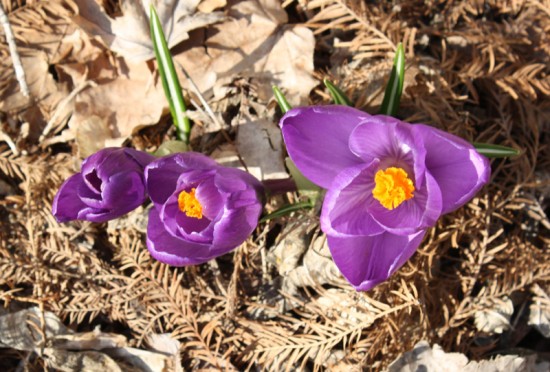
First Bloom of 2015
So I’m sure we’ve all seen these commercials. The Mantis tiller, plowing through soil, I never bought into it. My only memory of using a tiller was when young, at my parents, a big tiller, twice as big as the mantis easy, and it’d have trouble breaking through the soil. Plus in the commercials it always looked like potting mix, it seemed so staged. So sure, I thought, of course the tiller would plow through light potting mix, I bet it wouldn’t do anything on actual garden soil.
Then the nice people at Mantis offered me a free tiller (best part about being a garden blogger: the free swag. Second best part? Potential tax writeoffs). Of course I accepted, because free, but I really didn’t think I’d get much use out of it, because I was skeptical. I did ask for a 4 cycle one because I don’t like having to mix 2-cycle gas. Most often they are sold as 2 cycle ones.
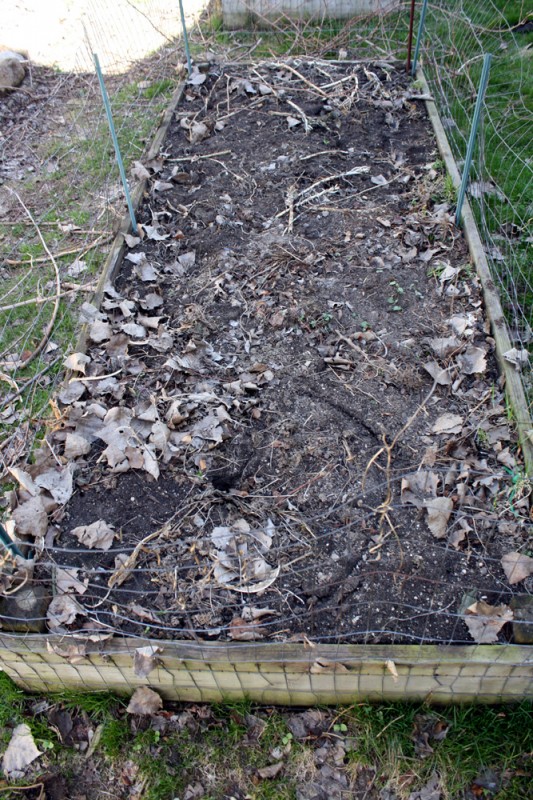
My garden raised bed as it is found in Spring, old plants, a few weeds, leaves, etc.
We finally had some nice weather and I decided to give it a try today. Assembly took about 30 minutes and was straight forward, but you need your own tools, it doesn’t come with the wrenches you would need. It took me awhile to get it started and I got a little frustrated, the pull cord on the engine is a bit short, and rather than giving in long pulls, you need to hit it with a few short rapid pulls to get it going.
But once it was going, wow, it completely powered through my raised beds. Admittedly these are raised beds, so they are not compacted by foot traffic, however they are many years old the dirt wasn’t fresh by any means. Hand turning with a pitch fork, my prior MO, would take 30-40 minutes at least to do a good job, and it wasn’t nearly as complete a job as the Mantis just did, and the Mantis did it in about 5 minutes. No joke. This thing is strong enough for heavy garden soil. It might not tear up sod, but garden soil it does just fine. Just be careful near fences, at one point it caught my little fence (stupid groundhogs) and that wasn’t a good thing, it got all tangled up.
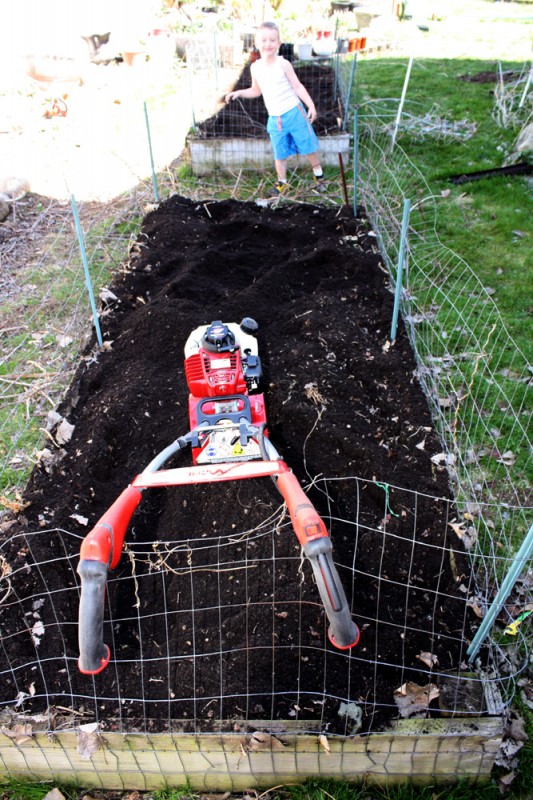
My garden bed after less than 5 minutes of action with my new Mantis tiller.
Tilling is a little controversial in gardening circles. It can destroy the tilth of the soil, it can bring old weed seeds to the surface where they can annoy you to death, some claim it can make a hard layer underneath (this I care less about, plant roots tend to stick to the top 12 inches of soil). In general this is all true, and certainly it makes sense to let the soil lie in many beds, but I just don’t feel that is true for vegetable gardens.
Vegetables need loose soil to grow their best, obviously any root vegetable does best in light and airy soils, a compacted hard soil will give you smaller and deformed potatoes, beets, and carrots. But even other plants benefit from having looser soil to push their roots through, the plants will grow bigger, faster, and getting big fast is the quintessential goal of a vegetable garden.
Tilling also has one good benefit, mixing amendments in the soil. For instance I had all this old waste from the prior growing season, random fallen leaves, and things like that, I also tossed on a few buckets of compost. The tiller blended it all in nice and clean. All in a few minutes work. It almost seems wasteful, this machine for this small amount of space, but soon, very soon, I will have my epic Martha Stewart sized vegetable garden, then I will get more use out of it.
The bottom line is the Mantis went all over my raised beds, as deep as a foot down, with ease, blending the soil in minutes. It was great, I can definitely recommend it.
On March 31st I noticed the first bloom of the Spring, a crocus as always, same spot as last year. The first bloom last year was also March 31st.

First Bloom of 2015
Here is my Michigan Misery Index over time:
2009: March 15th
2010: March 16th
2011: March 15th
2012: March 10th
2013: Forgot
2014: March 31st
2015: March 31st
Winters have been getting both colder and longer lately. 2014 was just horrible. 2015 had a warmer early part of the winter, but the cold lasted so long and dragged out well into Spring, we had snow falling less than a week ago still. I enjoy recording these dates, it lets me see patterns in my garden over time. I think perhaps I should start recording dates for other events, such as trees blooming.
This is the last time I’m going to be doing this for Michigan though, we move to Tennessee this summer. My flowers will come up in February or something, how nice will that be?
Sometimes a little bit of knowledge is a bad thing. I’ve talked, multiple times, to novice gardeners, hobbyists (and, lets face it, I’m a hobbyist too, I don’t have a degree in horticulture, I am not a professional landscape architect, but I’m a garden blogger, gardening is serious business to me), laypeople, or just people who simply don’t know much more about gardening than what the tag on the pot at Home Depot tells them. A common theme I’ve noticed is the misidentification of bugs, specifically in regard to two pests.
Japanese Beetles and Lady Bugs
I thought everyone know what a lady bug was, I mean, they’re represented in cartoons, tv, media, clothing, art, various other cultural representations, and yet still I’ve had multiple people tell me, convincingly, that a lady bug is a Japanese beetle. They think, perhaps, that if they see a lady bug of a slightly different hue, or with a different spot pattern, it must be this Japanese beetle they’ve heard about, this nefarious invader. I don’t know why they have this confusion, but it is rather alarming, considering lady bugs, or lady beetles, or ladybirds, (the insect has a variety of regional names) are generally beneficial insects that eat things like aphids, and you have people killing them mistakenly thinking they are Japanese beetles. Stop the insanity!
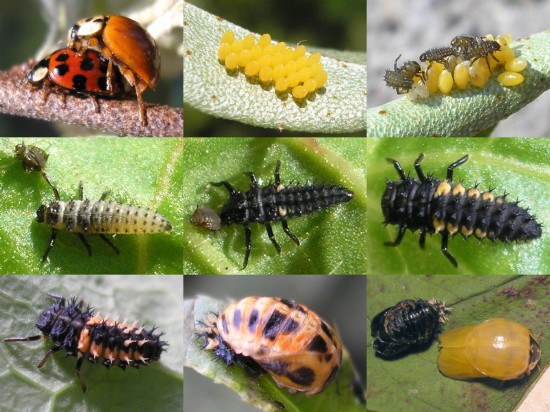
This is the full life cycle of the Lady Bug, pay attention to the scary looking larval stages, those aren’t little monsters, if you see them in your garden do not squish them.

An actual Japanese Beetle. Notice the coppery wings and the iridescent green thorax. Big and slow and invasive, they should be killed when seen.
What is an actual Japanese beetle? It is much larger, about the size of a nickle, or a man’s thumbnail, they’re slow, ponderous, they eat plant leaves, not insects, leaving skeletonized leaves, and they’re iridescent (shiny, metallic like) green & copper colored. When you positively see one they’re rather obvious and you’ll never make the mistake of misidentifying them again. They have a variety of control methods, and as they’re slow are easily hand caught/squished. They were first discovered in New Jersey in 1916 and have been detected in 30+ states, though have not fully penetrated the western US.
Box Elder Bugs and Stink Bugs
This confusion is perhaps more forgivable. Box Elder Bugs are native bugs that feed off of boxelder, maple, and ash trees. Anything in the acer family. They’re red and black (same coloring as most lady bugs, and people also often sometimes think these are Japanese beetles), and while they feed on the trees, not on insects, they usually don’t cause permanent harm and aren’t considered an agricultural pest. They can however be annoying, they like homes, they like the warmth seeping out of the walls, they can find their way indoors, and they do have an odor when squished, but they’re not really harmful or invasive.
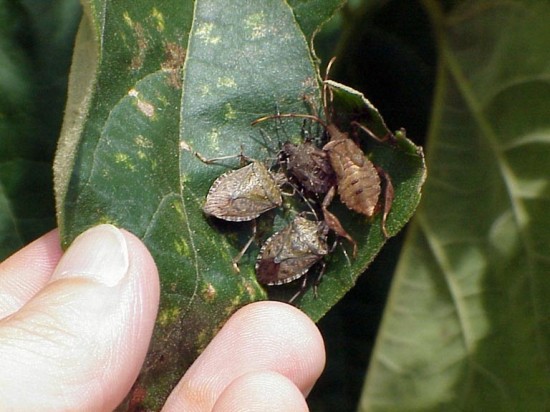
If you see these, squish them, they’re invasive destructive pests.
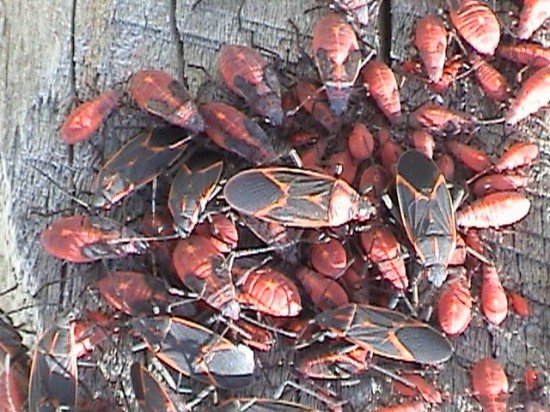
Adult and juvenile box elder bugs. They may be annoying, but aren’t that harmful.
So people hear on the news about an invasive stinkbug that is a huge agricultural pest and think “aha that must be this thing.” It isn’t. The invasive pest stinkbug is the brown marmorated stinkbug. This bug is a serious agricultural pest, and like the Japanese beetle is somewhat slow and easy to catch & squish (though, it can be smelly). If you see one of these bugs, please kill it, it isn’t native here, it is destructive to our environment.
Why the confusion
I think a lot of the confusion results in the invasive nature of these pests. For instance, the brown marmorated stinkbug has only shown up in my garden in south central Michigan this past summer in any large numbers. Previously I had only ever seen a handful (outside of gardening magazines or TV shows). They were first found as recently in 1998 in Pennsylvania areas and have been slowly spreading west and have heavily colonized the DC/NYC east coast areas. So people in the rest of the country hear about the bug long before they ever seen one and so potentially misidentify it. These little suckers are really clingy, they have strong legs and I’ve seen them ride on cars without falling off, which may be aiding in their spread.
I cannot stress enough how important it is that you kill any of these bugs that you see, both Japanese beetles and brown marmorated stinkbugs are horribly invasive pests that are destructive to our native environment. Both are slow enough to be hand killed, Japanese beetles also have very effective pheromone based traps you can buy. I do not know of an effective commercial trap for stinkbugs. But, just make sure you’re killing the right bugs, and spread the knowledge around, public education about these insects is important. And, please, if you catch them in your house, don’t “release them into the wild.” Don’t be that person, they’re a nonnative invasive species, you’re not helping nature when you do that, you’re hurting it.
I think everyone loves a nice mass planting. Mixed plantings look nice too, but it is hard to beat the statement of a mass planting. A whole bed of lilies, a whole bed of hostas, a whole bed of daylilies, or cone flowers, or rudbeckias, or phlox, or whatever. Maybe not all the same exactly hybrid, but all the same species.
But man, sometimes, gardening can be expensive. Even if you were buying them for $1 each (unlikely) or $5 each (more likely) you’re looking at spending hundreds of dollars to pull it off.
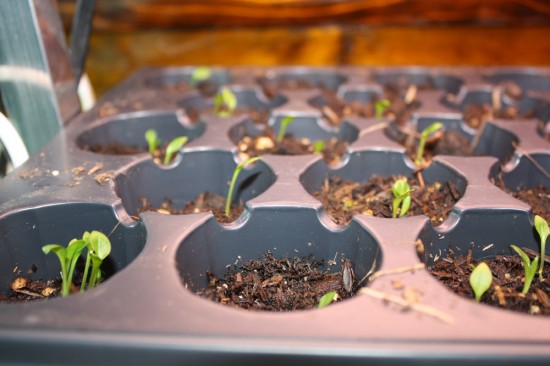
However, if you have patience and a little equipment (or a nice south facing window) you can get those plants for a lot less.
Hybrids
Most perennials you buy are hybrids, which means they are a specific plant that has been cloned to be reproduced. So every Stella de’oro daylily looks like every other one, they have the same genetic code. When you introduce sexual reproduction (with bees & seeds) you get different plants. So if you saved a bunch of seeds from Stella de’oro many would look the same, but many would also look different. So the first thing you need to remember when saving perennial seeds is that they will not grow the same as their parents. That is okay though, with hostas a bunch of different leaf shapes, sizes, and colors are desirable in a mass planting, and so long as you aren’t a collector most flowers like lilies or daylilies are the same.
Selecting & Prepping Seeds
Different seeds have different requirements for germination. Generally you should wait to harvest the seeds until the plant is ready to give them up. That means the seedpod is brown and starting to crack open on its own. Harvest and sort the seeds, separating them from the pod and any other plant remnants. Generally you may need to dry them out a little more, so don’t store them in an airtight container, a brown bag is fine or an open jar.
Now you’ll have a little bit of research to do. Some plants need what is called stratification, or a cold and or wet period, to germinate. They get this naturally by sitting on wet ground during winter, but you will need to mimic this indoors. So if you’re growing a seed that requires this (like daylilies) you can put them in an old butter container or something in some water in the fridge for 6-8 weeks. At the end of this time often you’ll see the seed outer coat start to split open, and that means it is time to plant.
With other plants that do not need stratification, such as hostas, you can skip that step.
Regardless if you needed cold storage or not, the next step is heat, plants tend to germinate in the Spring when the soil warms up, and it is that warming of the soil that does it. So get a plastic seed starting tray, I like ones with 72 cells, and you’ll need a lid for it. Plant your seeds and again you’ll need to do some research as to planting depth, but generally a quarter to a half an inch is appropriate for most perennials. Then water with warm water and put the lid on. You can also spring for a seedling heat mat to put under the tray if you want, or otherwise keep it somewhere warm like near a radiator.
You also need to do a little research and see if the plant you are trying to grow needs light to germinate, in which case you really hardly plant the seed it all, but put it on top of the dirt and just sprinkle a little potting mix on top. If the seed does require light to germinate you should put it in a south facing window, or if not you should put it beneath a grow light setup. And that is the one cost you’ll incur that isn’t so cheap if you don’t have a south facing window (I don’t currently, blech). With your grow lights you need to place it as close to the plants as possible, and then raise it up as the plants grow. Remember that, people usually don’t and just stick it something like a foot above the plants which is too far (until the plants are 10 inches tall anyways).
Somewhere between one and three weeks your seed should germinate, and I really recommend planting 3 or 4 seeds per cell because not every seed will germinate and you can always cull the excess ones.
After Germination
The best time to start this process is in winter, so after germination it is likely too cold to plant outside still. So you’ll need to put them in that south facing window and or under your grow light. Take the lid off the tray now as you can let the humidity escape the soil since germination is over, however you will now need to water the tray regularly (and gently).
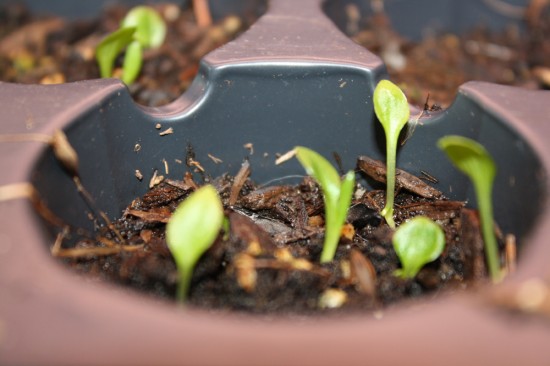
I also highly recommend putting a fan near the plants to provide them with wind, an oscillating fan is best but any fan will do. Plants grown in still air develop weak spindly stems and do not do well when finally placed outdoors.
If you’re growing under lights continue to adjust the lights upward as the plant grows taller and wait for the weather to warm up.
The Fruits of Your Labor
Once the weather warms up to a safe level you can bring the plants outdoors, however they’re unlikely to be ready for it. You need to harden them up by putting them outside during the day, and taking them in at night, for as long as 2 weeks, also starting them in the shade and only gradually introducing them to full sunlight. Even if they were in a window before. Plants grown indoors usually can’t take 8 hours of full sun at first after being indoors all their lives.
Once they’re fully adapted to the outdoors you can plant them in a permanent spot, but now you must wait. Perennials grown from seed take a long time to develop. If you cut a division off a daylily to make a new plant you’ll get a flower than year or the following year. A daylily grown from seed may flower in year 2 if you’re lucky, but perhaps not until year 3. Other plants like hostas are the same. If you save seeds from a big beautiful hosta with massive leaves, the seeds are going to be different from the parent but still likely will be a large leaved hosta – but it will take 5, 6, 7 years for the hosta to mature to be that size.
So you need patience, but on the other hand, this is a cheap and easy way to get a ton of plants.
I’m moving next summer and in my new place I’ve going to have exponentially more garden room than I do currently, but I’m loathe to think of all the work and spending it will take to plant all those spaces. So I’m preparing now. My current project is seed starting hostas, and the pictures in this post are from that. They won’t be named hybrids, but they’ll eventually be nice big hostas and will look good in a mass planting I’m hoping to have on the shaded side of the house. I’ve previously done this with daylilies though by now I have so many daylilies I can take divisions from I don’t feel a need to use their seeds (also I find hostas harder to divide by divisions than daylilies).
You can of course also do this with annuals, not just perennials, however annuals are so much more expensive in the end (having to be grown from seed every year, not just once) I don’t really think they belong in a post about frugality. Perennials are always the frugal choice.
Perennial seeds aren’t something you can usually buy at the garden center or grocery store like annual seeds. If you can’t save your own from your plants in your existing garden, try a gardening friend or ebay. Lots of people sell perennial seeds from their garden on ebay.
In the inland empire of California is a vast stretch of hundreds of square miles of almond trees. Every spring 1.6 million beehives, 60% of the managed beehives in the country, are trucked to California to pollinate these almond trees. It is the largest pollination event on earth, and is responsible for 80% of the entire planet’s almond production. But why? Why must the bees be trucked in? For the time that the almond trees are in bloom that area is a cornucopia of bee delight. But what happens when the almond trees are not in bloom? It is essentially a desert for bees. Monocultures are not natural and while bees can fly over a mile from their hive for food, hundreds of square miles is too large of a distance, and if almond trees are the only things planted, then what is there to sustain the bees for the majority of the year when the trees are not in bloom?

Hives on pallets trucked to an almond farm.
There are other problems with this practice, such as by trucking a majority of all our commercial bees to one spot for a giant pollen party we facilitate the spread of disease, but this also serves as my introduction into how to grow a bee friendly garden. I’m providing you a real world example of what might seem to be bee paradise as an example of what not to do.
Feed the Bees
Many animals figure out how to survive when food is scarce. Some will pack on the pounds while food is plentiful, and then live off those reserves when food is scarce, others will store or hoard food in burrows or caches like a squirrel. Bees do a bit of both, storing the honey for when there is nothing in bloom, such as winter. However, bees need a full Spring, Summer, and Fall to put away the honey they need for a winter. A two week almond bloom is not going to generate enough to sustain them the rest of the year.

Bees need flowers as early as possible in Spring, crocuses are a great choice.
So the single most important thing you can do to make sure you have a bee friendly garden is to make sure there is something in bloom in your garden as close to year round as your climate can manage. This means you should absolutely positively plant the earliest spring flower you can find, which is likely going to be a crocus or a snowdrop, and also plant the latest fall flower you can think of, such as an aster or a mum. Those are all perennials but it’d also be helpful to plant annuals by starting them indoors and putting them outside as soon as they can take it, blooms at the ready, and leaving them out, blooming in full force, until the frost finally kills them.
There are also plants you probably don’t even think of as being flowering plants, such as maple trees, that can add to the bee’s diet. In general you just have to remember that within a mile of a hive bees more or less need something in bloom constantly straight on through from Spring to Fall.
Colony Collapse Disorder
You may have heard of this, colony collapse disorder, or CCD, before. Essentially, in recent years, for some reason, bee hives are dying and people do not know why. The science behind it is a little fuzzy or nonexistant, allowing people to attribute it to anything and everything under the sun. People who dislike pesticides say pesticides are causing it. People who dislike technology say it is cell phone and WIFI signals causing it. People who dislike genetic engineering say (stupidly) things like genetically engineered corn (which is wind pollinated natch) is causing it. One of the more interesting theories I’ve heard is that loss of bee habitat and or loss of wildflowers have caused it. If you think about it, a field of wheat or corn provides little sustenance to bees, and how much of the surface of the earth that may have once been a meadow filled with wildflowers is now wheat or corn? This doesn’t entirely make sense though because I’m sure apiaries (that is, bee keepers) don’t keep their hives in the middle of corn fields. And this wouldn’t explain why a bee hive, presumably kept surrounded by flowers, would collapse. However, what is indisputable is that bee populations are dropping and you can help prevent that by planting more flowers and doing other things discussed in this article.
Other Bee Friendly Steps
In addition to planting flowers that stretch their bloom periods for the full growing season, you also want to try to make mass plantings of such. Bees can’t find or can justify the energy to find a single crocus blooming, but a vast swath of crocuses will be worth the trip. So try to plant a square yard of each of the plants you choose to provide for bees, ideally close together so the bees don’t have to go very far to find the next bloom.
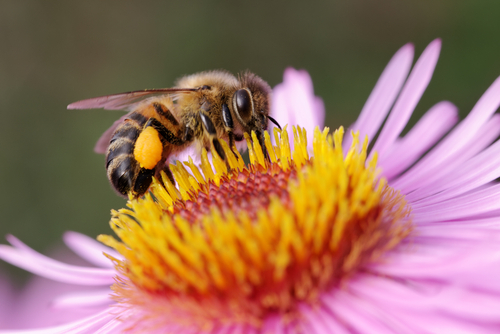
A bee out foraging for pollen and nectar, notice the pollen stored on his leg.
You should also try to limit the spraying of insecticides, obviously, since bees are insects. You can still spray but you shouldn’t spray while the bees are active, which generally means only spray later in the afternoon and try not to spray flowers or plants that are actively flowering.
Bees also like a drink of water, water features can help attract bees (and other wildlife). If you can’t put in a pond or fountain, a simple bird bath can help.
Also don’t hate on weeds so much, and considering naturalizing your lawn with something like white clover, which bees love, which benefits lawns and lawn-owners in many ways. See the link for more information on that.
You can also of course get your own beehive. Beekeeping is not that expensive to start with, if you can build your own hive the other equipment could be had for around $100, and that single hive could give you as much as 50 pounds of honey. But if you’re not ready for that step, simply providing habitat for all the neighborhood bees will be helpful.
What about all those stingers
Bees, and honeybees in particular, are not really aggressive, they just want to be left alone, and they will leave you alone. Obviously people with a diagnosed allergy to bee stings need to be extra careful but for most of us just don’t both them and they won’t bother you. You can not plant bee favorites right by walkways or sitting areas, but otherwise special attention isn’t really necessary.
Other Bee-nifits
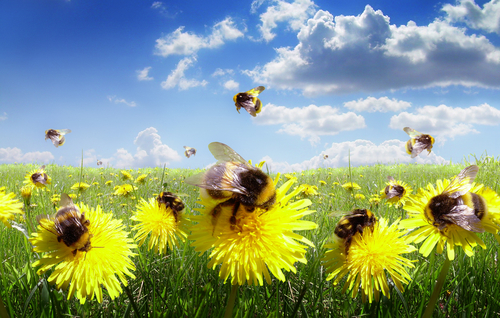
You don’t need to merely make a bee friendly garden out of the kindness of your heart, you can do it for entirely selfish reasons. If you grow any sort of food crop that is bee pollinated, the bees you attract should increase your yields. I get questions all the time from gardeners growing squash of some sort saying the female blossoms just die off and never develop – which means they weren’t pollinated, which means you need more bees. And certainly if you have an apple tree (which everyone should have) you’d rather see it crammed with apples rather than sparsely covered.
Bees and their cousins also tend to keep undesirable insects at bay, the more beneficial insects you have, the less bad insects you usually have. Plus you get to enjoy all the same flowers as bees do.
Which flowers are best?
There are numerous lists of bee friendly flowers out there, and more or less, any flower is a good flower for bees. Some are more suited for different types of bees though because of the flower shape or depth. In addition to the aforementioned crocuses, snowdrops, white clover, mums, and asters, I want to give a mention to silver dollar plants, which also bloom very early in the Spring, and of course all the other bulbs.
In addition though, here are some plants which I have noticed honeybees specifically loving in my own garden: sedum (all types, but especially upright ones blooming in late summer/fall). privet (known for a hedge but has lilac like blossoms), boston ivy (yes, it flowers, and the bees love it), scabiosa, butterfly bush (butterflies and bees generally like the same things), coneflowers, and roses (but more open ones without so many petals that the flower internals are hard to see). Generally if it is fragrant, it is a good bet, and if it has open easily accessible pollen, it is a good bet.
Then all the flowering trees are also good ideas, as I said above, bees like a cluster of flowers so they can just hop from bloom to bloom, and what provides that more than a whole tree covered in blooms. So any of the edible or ornamental flowering trees (especially considering they flower in Spring when so little else is in bloom) are a good idea to plant.
Otherwise I’ll assume you, or your neighborhood, already has flowers available for the bees during the long days of Summer, so don’t put too much thought into what to plant in those months. Try to focus though on specifically providing some sort of flowering plant in Spring and Fall as those are the months when food might otherwise be scarce for our friends, the bees.
So there was a guy, you may have heard of him, William Shakespeare, he was sort of a big deal. He was of course an English writer and his works have been popular for almost 500 years, that is some staying power. I actually like his stuff, I’ve read Shakespeare for pleasure, I’m that sort of nerd. Some people though, they take their devotion to the Bard to the next level.
For instance, the annoying invasive English starling was introduced to North America by some fools who wanted to bring every bird mentioned in Shakespeare’s works to our newer continent. So, in 1890 some hundred starlings were released in New York’s Central Park, now there are some 200 million of them from sea to shining sea. These same people are also responsible for the house sparrows that are everywhere now.
I do not recommend an homage to Shakespeare in the form of fauna, but flora is certainly fine. It is actually a thing to create a Shakespeare Garden.
English Gardens
There are two quintessential English gardening styles. There is the formal English garden, and the English cottage garden, either I think would be appropriate for a Shakespeare garden, though I personally feel the formal style is more suited.
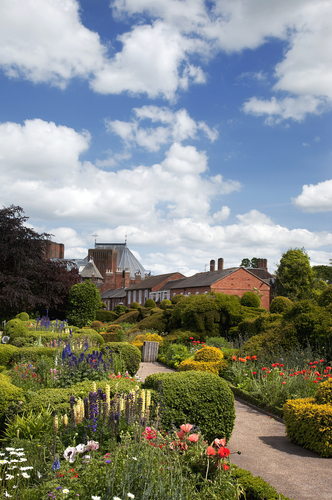
Cottage Style Garden by Royal Shakespeare Theatre
An English cottage garden grew out of functional needs of small landowners in rural England, land was always strictly apportioned and commoners did not have much, so they had to make due with what they had. So the look of the cottage garden is one of very dense almost haphazard planting, a wide variety of plants but not many plantings of any single one plant. These gardens were planted for function so mostly would contain herbs and edibles and flowers mixed in to bring in pollinators or to aid in honey production. But it is all mixed together. At my current house my garden style is largely that of a cottage garden, and I’ve blogged before about things like edible ornamentals, those are all very at home in a cottage garden. Cottage gardens are also often enclosed by stone, bricks, sometimes a low fence, and they tend to make use of arbors and trellises.
A formal English garden is practically the opposite, this is for when acreage is no problem. These gardens are known for their orderly symmetrical hedgerows, precisely pruned topiaries, and geometric designs. Often they are divided into rooms or sections and contain small ponds, statuary, and other things. You can technically make a small formal garden, you can even have both formal and informal gardens on your property (I intend to do that at my next house) but it isn’t the sort of garden you can tuck into a corner between the porch and the house, nor does it lend itself stylistically to most houses.
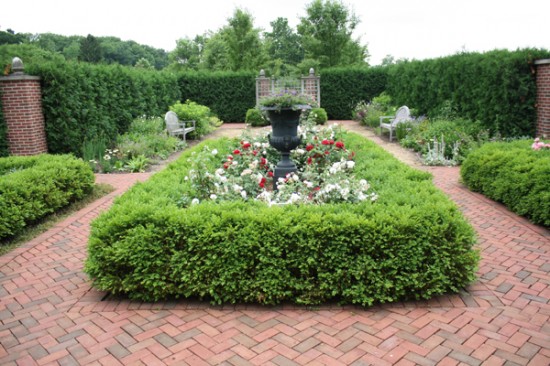
Formal Garden Style
Another way to think of them is that cottage gardens often have curves. Curving pathways, curving borders, not much order, not even numbers of plants, no rows of anything. Formal gardens have more straight lines, straight paths, square borders and beds. The exception is perfect circles, you will still find them sometimes within a formal garden, and you could have curved topiaries or hedges in a celtic style design or something in a formal garden, but still usually in a square or rectangular bed.
Shakespeare Gardens
You could turn either of these styles of gardens into a Shakespeare garden. So what would make them a Shakespeare garden? The simplest way is to plant plants that have been mentioned in Shakespeare’s works. The next step if you wanted to put a little more work in would be that, instead of simple plant labels, you could include quotes from the plays mentioning the plant as a label. For instance, by a rose, you could have a little wooden sign saying “A rose by any other name would smell as sweet.”

Bust of William Shakespeare
Moving up the next step would be including statuary, using a bust of William Shakespeare himself. Then also bronzes or bronze plaques with the quotes rather than wood, although those all are more typical in a formal style of garden.
A Rose By Any Other Name
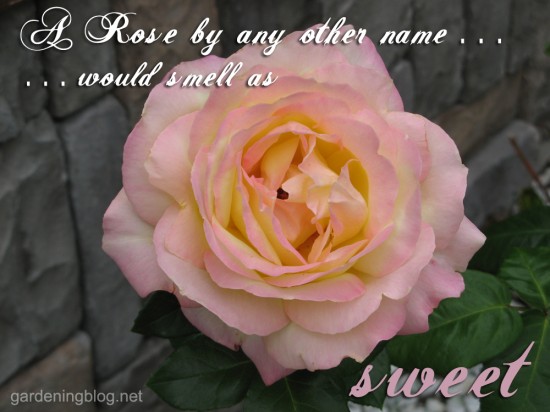
– William Shakespeare, Romeo & Juliet
Why are roses popular? Really, why are roses popular? Have you ever thought why some things are popular and some things are not? Roses are sweet smelling, but so are lilacs and lilies. Roses have thorns, they have numerous pest and disease problems, why are they so popular, especially among the English speaking people? Could it be because of Shakespeare? In earlier medieval times lilies were as popular than roses (and if I’m being honest, I prefer them today, not so many pest and disease problems, also no dangerous thorns), but then roses took over? Could it be the Shakespeare effect? Roses are mentioned more often than any other flower in his works, and here we have a literary collection that has been consistently popular for nearly half a millennium. Going back hundreds of years ornamental gardening was strictly a pursuit for the literate classes, so it is certainly possible that some of the most popular literature of the era could have influence on gardening. Much in the way we have little babies named Khaleesi wandering around, media influences our behavior and tastes. I don’t see why we couldn’t lay the responsibility for the popularity of roses at William Shakespeare’s feet.
Visiting a Shakespeare Garden
As I said above, Shakespeare Gardens are definitely a thing, I’m not making this up. You can even visit one, or many. You may have visited one before, this little place you may have heard of, Central Park in New York City, has a Shakespeare Garden. There are in fact at least two in the greater NYC area, two in Connecticut, a nice one in Cleveland, a couple in Illinois, one at Golden Gate Park in San Francisco, of course the most famous one in Shakespeare’s hometown of Stratford-on-Avon, and even one in my future home of Chattanooga (well, maybe there will be two there one day, hint hint), and lots more all over. If you were thinking about combining your literary and botanical pleasures, you could visit one of these sites, or visit just for fun without taking notes.
Potential Planting Possibilities
The list of plants mentioned by Shakespeare is long, you probably already grow many of these, if you wanted to pursue this form of garden design, here it is:
aconitum (monkshood), almond, aloe, apple, (also crab, pippin), apricot, ash, aspen, bachelor’s button, balm, balsam and balsamum, barley, bay, bean, bilberry, birch, blackberries and brambles, box, brier, broom, bulrush, burdock, burnet, cabbage, camomile, carnation, carraway, carrot, cedar, cherry, chestnut, clove, clover (or honey-stalks), cockle, coloquintida, columbine, cork, corn, cowslip, crow-flower, crown imperial, cuckoo-flower (buttercup), currant, cypress, daffodil, daisy, darnel, date, dewberry, dock, dogberry, ebony, eglantine, elder, elm, fennel, fern, fig, filbert, flag, flax, flower-de-luce (iris), fumitor, furze, garlic, gillyvor (carnation), ginger, gooseberry, goss or gorse, gourd, grace (rue), grape, grass, harebell, harlock (burdock), hawthorn, hazel, heath (ling), hebanon (possibly yew), hemlock, hemp, herb of grace (rue), holly, holy thistle, honeysuckle, hyssop, insane root (mythological), ivy, kecksies (hemlock), knot-grass, lady-smock, lark’s heels (larkspurs), laurel, lavender, leek, lemon, lettuce, lily, lime, ling, locust, long purple (probably orchis morio, o. mascula), love-in-idleness (pansy), mace, mallows, mandragora, mandrake (mythological), marigold (calendula or pot marigold), marjoram, marybud (marigold), mast, medlar, mint, mistletoe, moss, mulberry, mushroom, musk rose, mustard, myrtle, narcissus, nettle, nutmeg, oak, oats, olive, onion, orange, osier (willow), oxlip, palm tree, pansy, parsley, pea, peach, pear, peony, pepper, pig-nuts, pine, pink, plane tree, plantain, plum, pomegranate, poppy, potato, primrose, pumpion (probably gourd), quince, radish, reed, rhubarb, rice, rose, rosemary, rue, rush, rye, saffron (C. sativus), samphire, savory, sedge, senna, speargrass, stover (grass), strawberry, sugar, sycamore, thistle, thorn, thyme, toadstool, turnip, vetch, vine, violet, walnut, wheat, willow, woodbine (honeysuckle), wormwood, yew.
Source: The Plant-Lore and Garden-Craft of Shakespeare, by Henry N. Ellacombe. W. Satchell and Company, London, 1884.
Big list huh? Shakespeare was really into plants. If you wanted to find the exact quote for the plants this site has a william shakespeare works search that’ll fulfill your needs.
I hate moles, really I do. I know there are people out there that probably do not condone killing any animal, even moles, I’m not that type of person, but if you are, I can respect that, though this blog post is not for you.
Personally I like animals fine, I try to encourage animal habitat and would never hurt an animal out of spite, however I’ve hunted in the past, and will again in the future, and when that woodpecker destroys my siding, or that ground hog destroys my garden, or a mole destroys my yard, its game on.
And really, I grew up in the woods, our mailbox was a mile from our house. We lived down a dead end dirt road, at the dead end of the dirt road, this was nature people, and do you know how many moles my parents have crawling under their yard? None. How many ground hogs tore up their plantings? None. (though, deer always did). How many woodpeckers… well until they got vinyl siding those were a problem, but my dad took care of them with a 12 gauge. The point is, I see more rodents on a daily basis living in town than I ever did living out in the forest. Why? Because there are more predators in the forest, they keep the population in check. In town, not so much, so the population gets out of control. So for those who feel that it was their land first and we’re the intruders, remember that if not for us, in fact, there would be less of them. We created the environment in which they thrive, unfortunately.
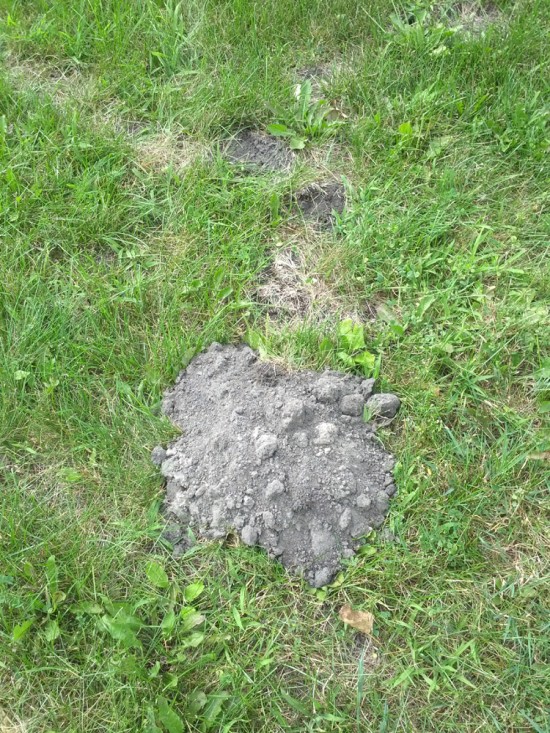
A Mole Hill
So moving on, I’m going to talk about how to kill them. I know of no known live traps for moles, sorry, while there are deterrents they do not seem to work well and will just drive them to your neighbors yard. Still, I will cover them first. Also, I’m going to talk about voles. Voles are like smaller moles (more or less mice). They will both leave tunnels in your hard, but they are different animals. Voles will leave smaller tunnels and not tend to push up big mounds of dirt, they’ll also eat plant roots and kill them potentially. Moles tend to be carnivores, eating grubs and worms, will make bigger tunnels, and push up mounds of dirt when they make a den.
Milky Spore
Milky spore actually seems to work, though I’m not entirely sure because it isn’t something I’m able to scientifically check and study, but to me it seemed to work. What it is is a bacteria that kills grubs, which is a prime food source for moles. One application can last for 10 years in your yard, or more even, as the bacteria thrive and reproduce and continue to kill grubs. Second plus, fewer Japanese beetles. This might be a solution for the more squeamish as it kills grubs and not moles. The good thing about this solution is that it is easy to treat your entire yard at a reasonable price. It can be hard to find locally, I recommend purchasing it online.
Castor Oil
Castor Oil (the same stuff used to make Ricin by the way) is supposedly abhorrent in odor to moles, and can scare them to your neighbor’s yard. This to me did not seem to work, though I’ve used it, it isn’t that expensive but unlike Milky Spore it doesn’t last very long at all. You can get it in sprays to attach to the end of a hose or in granular form. You’ll probably be able to find this locally no problem.
Sound Devices
Some vendors make these sound devices you stick into your yard that create vibrations in the subsoil that supposedly will drive moles away. I’ve seen these used in my neighborhood, but I’ve never used one myself. They’re worth a try I guess if you don’t want to get more medieval, but I cannot personally recommend them having no experience.
Traps
I have tried a variety of kill traps over the years, I’ve never once had a confirmed kill. Maybe I’m doing it wrong, maybe I’m setting the traps on the wrong tunnels. They often say “find the main tunnel” but if your yard is crisscrossed who knows which run they’re using all the time. Some traps are plunger based where the mole pushes up on the trap and spring loaded spikes clamp down. Others have a scissor like action where there are jaws open you put down into the hole and when the mole comes through them, clamp shut. Another one I’ve tried was more of a noose like trap, the smallest of the lot, you put down in the tunnel and covered up (and put in a marking flag so you remember where you put it). Again, I’ve never had a confirmed kill. I know professional outfits use traps a lot, so I imagine they do work, they just don’t work for me.
Poison Baits
Here I can buy these at Home Depot, but I understand they’re not legal in all states, I’m not entirely sure why. They come in a little yellow plastic cone bottle and you use the pointy end to poke a hole in the tunnel then dump in some bait. I’ve never ever seen a dead mole from using these baits, but I really think they work for me, as I usually notice less mole activity after using them. I sort of have to take it on faith that they work since there is no little rodent body for proof, but as long as the activity stops, I’m happy, so I’m happy to recommend them. There are also these poison worm baits which supposedly work even better. I will be trying them. I’m a big believer in poison baits for killing rodents.
Drowning
If you find a mole’s burrow you can put your garden hose down it and drown it out, this might also work to drown any mole babies down there. Sometimes it can help you finding the exit elsewhere as the water bubbles up. Of course the porosity of your soil will effect how useful this is. Also some people think that all you’re doing when you do this is giving them a drink of water up there. Also, if you do this, you should have a shovel (shotgun maybe) ready, because if they flee the water you’ll want to be able to whack them.
Patience
Speaking of whacking, if you have a beer and a rocking chair and a shovel you can just mow your lawn, stomp down a few hills, and then sit out there and watch your grass grow… and maybe, just maybe you’ll see a mole in action, pushing up the soil, and you can run over, stick the shovel in, flip it up, expose the mole, and whack it. The benefit of this method is you have a dead mole, so you know it works, the problem is the time needed to do it.
Suffocating
Another popular option is to take the exhaust from your lawn mower or car, put it into a garden house (so you stick the hose up the exhaust pipe while the engine is running – and that’s very dangerous for you so don’t breath that in) then stick the other end into the mole hole. The carbon monoxide will filter down into the mole area and they’ll die of suffocation. This might also work with dry ice. The problem is that you don’t know how extensive the burrow is and the gas might be coming up out somewhere else in the yard before it gets to the moles. Definitely keep animals, children, and even adults, out of the area while you try this. If the gas ended up emanating up under someone’s lawn chair that could be dangerous. Same thing with the water method, have shovel or shotgun handy. You can also do this with a little propane canister, like what you’d use for plumbing, remember many gases are heavier than air so they’ll sink down into the tunnels.
Flame On
This one is my favorite, though I’ve never tried it. You definitely should be a professional to do this, or at least, I’m saying, do this at your own risk. What you do is pump propane down into the mole hill like the suffocating method, and then… and then… you light it on fire. Boom! You burn them up or burn them out. This seems to me like it would be a very effective method, but as I said, I’ve not tried it. I do have a nice big propane torch which is actually a good gardening tool as I’ve blogged about earlier.
Summary
Any of my “shovel” options above you can also try with a pitch fork, in which case you can just try stabbing into the ground if you see the dirt moving. I’ve also heard of things like juicy fruit gum or human hair being repellents but I think those are likely old wives tales. One good idea I heard was getting worm oil from a fishing bait shop, and then coating your traps or holes or poison peanuts with it to attract the moles to their last meal.
What has worked best for you for dealing with these rapacious rodents? Leave a comment and let me know.
Controversy time, as a man a science (ahem, real science) I’ve been perpetually annoyed at all the anti-GMO pseudo BS out there, and I thought “What if there is a nice, accurate, informative, article out there letting people know the facts?” Then I figured, I might as well write the article. This post will be long, it will be informative, it may be a little bit funny at times, if you read it I hope you come away with a better understanding of what genetic engineering is, and why its good.
I’m uniquely positioned, perhaps, to write this article. I studied plant genetics in college, and I’m big into gardening, even organic gardening. So maybe people will trust me where others they wouldn’t? I have no financial stake either way, I studied the topic in school, but then switched to computer science I’ve never been employed by any sort of crop science company. My organic gardening credentials should be self evident (see gardening blog, etc), as well as my position as someone who cares about the environment (see blog posts on composting, planting trees, recycling, etc). So, hopefully, you trust me that I’m not trying to lead anyone astray, and I’m certainly not trying to sell you anything.
What is genetic engineering?
Humans have been tinkering with the genes of our crop plants since the dawn of agriculture. Corn used to have but one kernel, but then one intrepid farmer in ancient central america noticed a plant with two kernels, and he thought “Twice as much corn! I should save these seeds to plant again.” And over thousands of years of doing that, what we call selecting, the plant evolved with human help into what we have today. Cabbage, broccoli, brussels sprouts, kale, and cauliflower are all descended from the same plant, with kale humans selected for big leaves, with cabbage a big head of leaves, broccoli and cauliflower were selected for their florets, and of course brussels sprouts were I’m sure a random mutation that made no sense but tasted good so they kept it.
In the 1800s Gregor Mendel, a monk and the father of genetics, did experiments on peas at his monastery and more concretely defined how genetics worked allowing such plant breeding and hybrizing to be done most systematically.
Once we gained the ability to sequence a genome and actually look at the genes that governed traits we gained an ability to work even more systematically and modern genetic engineering was born.
So, how do you actually do it? Well in secret underground lairs scientists plot the end of the world by…. just kidding. In bright shiny sun filled greenhouses (with high security, I remember when I was a student working in a greenhouse it was all high security and I couldn’t figure out why, until I was reminded of the fire bombing a year before I was a student) you grow maybe a hundred thousand plants, these are wild types, just regular plants from regular seeds. Typically you’ll use a model plant for this, arabidopsis thaliana is the one used where I studied, its a plant that’s just easier to grow and study, like how so much genetic research for humans is actually done on mice, arabidopsis thaliana is the mouse of plants.

This is where the magic happens.
So you grow all these plants, and you look for outliers, weird traits, whatever it is you’re looking for. In the lab where I was they were looking at seed oil content, so what you do, and this is really, really, really, boring (and ultimately the reason I switched to computers), is harvest and catalog the seeds from thousands and thousands of plants. Then you need to analyze the seeds for oil content. One of the projects I worked on was using radial thin layer chromatography to analyze the oil content of the seeds so we could get a grant to buy like a pipette robot to analyze the seeds in bulk, this wasn’t even plant genetics, this was just doing research to figure out the process for doing plant genetics. Does this sound nefarious yet? College students in greenhouses harvesting and cataloging seeds?
So, you grow all these plants hoping for a mutant, like breeding humans and praying Wolverine pops out, then you find the mutant, and if you were back in prehistoric central america you might not even notice you had a mutant (who notices a 1% increase in seed oil content?). If you were in Victorian times you might notice with the aid of chemistry equipment, and you might care, and then you’d plant that seeds from that plant next year, and maybe continue to look for mutants. But now, now you can look into the genome and… well… how do you tell which gene (or genes) are actually responsible for the oil content? There are like a bajillion genes in an organism, who is the know which does what?
So really you need a couple mutants and look and see if they have any genes in common that differ from the wild type, and if so, then you can form an hypothesis and do an experiment, you take a wild type plant, and the mutant gene, and splice the mutant gene into the plant. The gene is native to the plant species, just not the specific member of that species. Some people worry this is playing god, personally I’m not religious. You can do the exact same thing by simply breeding your mutant with a wild type, then doing a genetic analysis on every single one of its children and further refine your hypothesis, but it is far more time consuming and difficult because with regular old plant sex you’re passing on tons of genes from the mutant, how can you be sure which one is responsible if the offspring has the desired feature? With engineering you pass 1 gene, and if it works, great, you’ve identified a gene governing seed oil production, if not, you’ve identified a gene not involved in seed oil production. This is the grind of science. The splicing, in the ends, just allows you to do a truly controlled experiment where the one uncontrolled variable is that spliced gene so you can be absolutely sure what effect it has. This is the only real way to get scientific certainty on the function of a gene.
Now you remember previously when I said that human gene research is largely done on mice? Its because our genomes are so similar, a gene that does something in a mouse probably does the same something in a human, so do we take a mouse gene and put it in your friend Walt? No, we use the mouse research as a road map. This same thing goes with plants, you do the research on arabidopsis thaliana, to learn which gene likely does what, and then you can apply that map to other plants. So if you identified genes in arabidopsis that boost oil production 1% you could apply what you’ve learned to rapeseed and allow farmers to grow canola oil with 1% less land, or 1% less fertilizer. Then, you go to work the next day and try to do it again.
So why is this good?
Does that sound all so bad? Well think about it. What if you took 10% of our farmland and turned it into forest. You’d clean the air, provide animal habitat, and sequester carbon, all of those things are good for the environment. Suppose farmers, even organic farmers, could use less fertilizer? You’d have less fertilizer runoff, which creates algae blooms that destroy marine ecosystems and can poison drinking water. 10% is even a modest goal, corn yields have gone up by a matter of like 600% just since the application of more simple Mendelian genetics (among other things, like better tractors, and everything else). Did you know plants have different types of photosynthesis, and C4 photosynthesis plants are exponentially more efficient than C3? engineering food crops to use C4 alone could give us a many fold increase in yields per acre. Then what if corn or wheat could be made to harbor nitrogen fixing bacterial like legumes? What if we could have perennial wheat? Where the plants grow large deep root systems (needing less water and less fertilizer – anyone who grows both perennial and annual flowers knows the big difference between them) and only needs to be planted once? Science is working on all of these things.
Norman Borlaug, was the father of modern crop science, and the best human every to live. He won a Nobel Prize, and when they gave it to him they estimated his work had saved the lives of a billion people, that is billion, with a B. You see, here in the developed world we have plenty of food, our supermarkets have fresh fruit from all over the world, year round, but not everywhere is that the case. There are still droughts, there are still famines, people still starve to death. If you can provide a seed that will allow a farmer to grow 10% more food per acre, or with 10% less water, or 10% less fertilizer, or whatever else you save lives. We have a growing population on this planet and we’ll need to feed a few billion more people in the future, and unless you’re one of those crazy population control eugenicist kooks (in which case, please never come to my blog again) you probably realize this. So unless you plan to bulldoze down all the forests to grow food, you need to do something. In many cases as well more nutritious food, higher in vitamins and minerals, can be developed using the miracles of modern science, which is a big deal in developing worlds where people still suffer from nutrient deficiencies.
Genetic engineering will literally save the world. It will allow us to grow more food on fewer acres with less water and less fertilizer.
But but but… what about…
What about what? Arguments against it? Sure, there are some, I’ll do my best to address the most common, most, as I’ll show, are either bogus or irrelevant.
GMO food isn’t organic, and organic is better, so… there!
So I tend to garden organically, I usually don’t spray anything, I use organic fertilizers, and I compost like crazy. But you know, organic gardening cannot feed the world. Suppose every farm tomorrow went organic, how many millions of people would starve to death? I mean, maybe we can get there one day, with genetic engineering, but then it wouldn’t be organic? Or is organic a largely arbitrary marketing label that can mean whatever we define it to mean? There are generally accepted definitions, but that all still ends up being semantics. Don’t garden or buy organic food because of a label, understand why it was labeled and what is behind that label and how that might or might not effect your health or the environment. Remember its all chemicals, organic chemicals still still chemicals, don’t assume something natural is safe, anyone who got e. coli from organic spinach would disagree with you. Like I said, I grow organic (mostly), and I shop organic (say half and half), and this post isn’t about organic gardening, but I’m saying that I believe there is a place for GMO seeds in an organic garden. Quite frankly, if I’m buying like beef, I’d rather go for the grass fed cow, than the organic cow, because the organic cow is just fed organic non-GMO corn and soy and that makes absolutely no difference whatsoever to the quality or health profile of the meat. I want to buy the animal not fed corn and soy, even if it isn’t strictly organic (though it usually is).
The whole organic gardening movement is about two things. 1. Being nicer to the earth. 2. Being more self sufficient with food production. I don’t see why the seed pedigree needs to enter into that at all, because GMO seeds can help with #2, and they’re completely agnostic to #1. Gaia doesn’t kill a kitten every time you plant a GMO seed, Gaia doesn’t know the difference.
Monocultures are bad, and if we give into these genetic overlords our entire food system could collapse.
You’re right! Monocultures are bad, and that is an argument against monocultures, not an argument against genetic engineering. A monoculture is where you grow all one type of plant, and by one type I mean where you have a whole industry wrapped around growing plants that are identical or almost identical to each other. So, if a new disease comes along that your plant is weak too, the entire industry can fail. Irish potato famine anyone? But I have another story you may have not heard of.
Until the 1950s (before we could genetically engineer anything), if you ate a banana in the US you probably ate a Big Mike banana, this cultivar provided us all our bananas, and as I understand it, they were better than what we have today. Unfortunately a fungus came along and killed them all, and now we all eat Cavendish bananas. See, monocultures are risky, or in other words, don’t put all your eggs in one basket. The cool thing is, modern genetic science gives us great tools to fight against any future such diseases. We could, for instance, identify which gene in the Cavendish banana gives it resistant to the fungal wilt, and then splice it into the Big Mike banana.
Monocultures are bad because of the risk of disease spreading, but that is an argument against monocultures, and plant genetics should be encouraged because it gives us the tools we need to keep our food safe from such emergent plant diseases. We’ve had problems with monocultures before we even knew what DNA was, it is an entirely separate issue from genetic engineering.
But I heard about pesticides and stuff..
You’re probably talking about Roundup-Ready corn. This is a corn strain developed that is immune to the herbicide Roundup, allowing farmers to spray their fields to better control weeds The weeds die, the corn survives. This is good and bad. It is an increase in efficiency resulting in more corn from fewer acres, but I don’t like such wholesale applications of herbicides. So I think we should throw all genetic plant science out the window… Just kidding, that’d be an entirely irrational response, just because I dislike one herbicide doesn’t mean I dislike crop science. This is one application of crop science, I would also hate it if scientists made corn that tasted like mushrooms. Suppose someone paints a really hideous house blue, do you then throw out all your jeans? If someone uses science in a way we dislike we don’t ban science.
And besides genetic engineering largely can be used to reduce pesticide and herbicide use. For instance, crops that grow closer together to shade out weeds, or crops naturally immune or resistant to pests.
You may have even heard of Bt crops, and they exist. Bt is the most common ORGANIC pesticide out there, it is a bacteria that produces a protein that kills some plant pests. So scientists figured out how to make plants make that same protein, identical to the organic pesticide, and the plants make it themselves. If anyone out there has a problem with that because they like organic gardening they’re a hypocrite. Literally a plant that produces its own organic pesticide. So if you bought potatoes treated with Bt on an organic farm it would be labeled organic in the store, but if you bought some Bt engineered potatoes it wouldn’t be, a distinction without a difference.
So if you have a problem with Roundup, have a problem with Roundup, don’t have a problem with crop science.
Genetic engineering companies are evil bad people who beat up poor little farmers with patent laws
So there is some controversy about plant patents and farmers being sued for growing unlicensed patented plants and some people have a problem with this. They don’t like it if a big company sues a little farmer (note, normally the farmer isn’t so little), or they dislike the concept of plant patents. Here your argument is for patent reform, it has nothing to do with crop science. To do otherwise would be like saying we should ban music because the RIAA sued Napster. But you know what patents do? They fund future research, so if you want more research, we need a patent system (but maybe that’s the idea for the opponents… they really do not want more research).
What about the precautionary principle?
So, the precautionary principle is just about the most conservative thing in the world, and I don’t mean “conservative” in the modern American sense, which is a label that applies to a political leaning that you would have called classical liberalism if you were born 200 years ago (political labels are meaningless), I mean the regular definition of being against change. The precautionary principle is basically standing athwart the progress of civilization, holding up a hand, and yelling “Stop!” It states that we don’t know if something could be bad, so we should avoid doing anything new. Now I think this is silly, we have science to tell us how things work, and scientific progress is a good thing and should not be stopped. It’d be like pulling the plug on the Internet because you were afraid Skynet would become self aware.
The precautionary principle people who bang the anti-GMO drum tend to say scary things like we’re all going to get cancer in 20 years because we’re eating poison. This is a claim without any sort of hypothesis, ask them to explain the mechanism through which they believe this will happen and they’ll throw up their hands and say you’re a shill for big corporate agribusiness. Fact is genetically engineered crops are still the same foods we’ve been eating, just tailored to our needs. What if that guy way back when had thought the two kernel corn was cursed and tossed it, not realizing it was the same corn, just twice as much of it?
They’ll say things like “Why do we need this? Whats the worst that could happen if we don’t do this?” Well, people die. Read this article and then if you’re a greenpeace supporter, STOP IT. People, children, literally died because antiscience nutjob luddites convinced ignorant government officials that GMO food was poison. Then you can also read about golden rice and weep for the blind children who could have saved their eye sight if not for the paternalistic action of a few activists who do not want to see scientific progress in agriculture.
Finishing Up
In my opinion, many of the instigators against genetic engineering come from political motivations not any actual genuine care for the environment. That is just a cover, they really want scarce resources because they believe scarcity will bring around their desired political change. Science that could turn the Earth into a cornucopia of food rubs them the wrong way.
The bottom line is this, if you’re against GMO food, you’ve already lost, sorry. I don’t mean you’ve lost because you’ve lost the argument and people are coming around to seeing how silly you are (though, you’ve lost that too). I mean that despite your best efforts, science marches on, and science has lapped you.
Our genetic engineering and sequencing skills have become so adept that we’re able to engineer plants in a whole new way. We use the regular way I outlined above to discover genes, and then because gene sequencing has become so cheap we can go ahead and sequence a bunch of plants. In a way we make another road map, we make a GMO plant and then analyze its genes to create a traditional breeding roadmap. A computer tells us which plant gets to have sex with which other plants from our library of plants whose genes we have sequenced, and with some traditional breeding we are able to make a plant identical (or near enough that makes no matter) to our GMO plant. They’re the exact same plant genetically, but one is technically GMO, and the other is not, so even if we had a label law (which I oppose, because I think it would create an unsubstantiated stigma, a scarlet letter), you could still have Roundup ready corn, and not have it be labeled. If you think about it, identifying crops with herbicide resistance is just about the easiest thing, much easier than analyzing thousands of tiny seeds for oil content. You just plant a bunch of corn in a field, then spray it, and see which stalks stay standing.
Ultimately GMO is a distinction without a difference, and that is the key point. Its just food people, it could be a random wild mutation (Yellow Delicious apples), it could have been developed by traditional breeding (aided by science and technology but no splicing) (Honeycrisp Apples), it could have been spliced together to speed things up (corn genes from one corn plant put into another corn plant to make…. corn), or it could have been spliced, and then (at greater time and expensive to appease political interests) reverse engineered in a greenhouse with dim lighting and romantic music playing using traditional breeding.
Then, remember, genetic engineering will allow us to reduce farmland, grow more forest, clean the air, sequester carbon, reduce fertilizer, pesticide, and herbicide usage while growing more food with more vitamins and feeding more people. It is safe, perfectly healthy, and good for the environment. So next time you get in an argument with someone, or someone posts on facebook about GMO food, kindly link them to this post and save yourself some time.

I find myself lately really enjoying double coneflowers (echinacea). Often in gardening we must make choices, do we want big, complex, showy blossoms, or do we want blossoms for a long period of time. Stella de Oro daylily blooms for a long time with relatively small plain yellow blooms, but there are other daylilies with amazingly large and complex blooms, that bloom for a fraction of the time. Irises make big showy blooms, some of my favorite, with multiple colors, but for maybe a week each Spring.
Coneflowers, to me, were always in the plain camp. They bloom for such a long period of time, but with wide spaced petals, and their most prominent feature being a big brown cone center, I’ll pass.
But lately double coneflowers have been developed, the first one, to my knowledge was not developed that long ago, I first saw them in gardening catalogs in 2005 maybe, in pink, but since then the pallets have expanded.
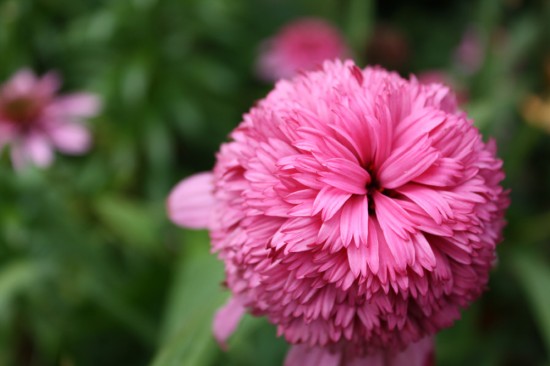
Razzmatazz Double Coneflower
These flowers are a great option for your full sun ornamental garden, they have big, beautiful showy blooms, and bloom for a very long time. They slowly multiply in the garden as well, filling the spot in which you plant them, and as perennials should come back year after year.
I think they could make a statement in a mass planting of a single color, I especially like the red ones. I also think they’d look great in a mixed planting of all different colors, well, the colors they come in. Red, pink, yellow, and even white so far that I know of. The white ones might work very well for a wedding.
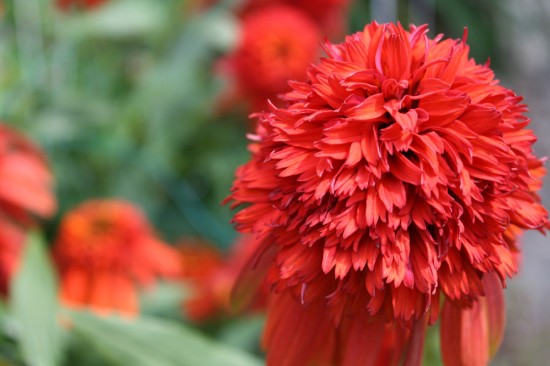
Hot Papaya Coneflower
They aren’t without issues though, anytime you get a double blossom on a flower you tend to have problems with the stems being sturdy enough to support the weight. The plant breeders selected for flower size, but not necessarily stem strength, so they can often need support, not always, sometimes mine do okay without support. But, I guess I should have said “issue” not “issues” as that is really the only thing I can think of. Animals don’t seem to bug them, stupid critters eat some of my other plants but never these. They’d work well in a cutting garden too if that is your thing. They’re even drought tolerant, and while Michigan and been more or less flooded with rainfall this year (I haven’t had to water the garden once except for containers), I hear out west it is pretty dry.
I had a chance to experience two of the worlds biggest flowers recently, only mere weeks apart.
The first was the infamous corpse flower, amorphophallus titanum (which means giant misshapen phallus). There is a specimen at MSU near my house that was flowering for the first time in years, and I dragged my kids there (they were troopers, waiting in line nearly 2 hours to see a stinky flower). It really is a rare chance, there aren’t a lot of them out there, and they can bloom as infrequently as every 10 years.

Corpse flower, for scale I’m 6’5.
The corpse flower is pretty cool, and is one of the largest flowers in the world. Technically they call it the largest unbranched infloresence in the world. It smelled like “squirrel in the ceiling” if you know what I mean, but it wasn’t overpowering, at least when I was in there, you had to stick you head down inside to sniff it (then again, they had the doors open and fans on so who knows).
This flower is rare, but not necessarily out of the reach of the common gardener. It is native to Sumatra and so you need to live in a tropical region to grow it, or have a greenhouse, or an interior room with enough sunlight to hold it over for the winter (bringing it back outside when the weather warms up). It seems to grow a bit like an amaryllis where it’ll put up foliage, in this case a structure that looks like a small tree, until it has enough energy stored up to blossom, and then the foliage all dies back and later the flower comes up, only perhaps only once a decade (and then only for a few days). Pollination as such is difficult, only a couple more were blooming nationwide when the MSU flower was in bloom, and they were trying to use fedex to exchange pollen.
So if you live in zone 10, or if you have a greenhouse or a room with enough sun exposure that can house such a large plant, you can indeed buy one of these, what a neat thing to have. If it blooms the kids can take it to school for show and tell. I’m thinking about it, for when I have my greenhouse.
A few weeks later I was taken by my wife to some botanical gardens at UofM for our anniversary and there, at that time, they had a century plant blooming. Century plants are pretty crazy, they can live for 100 years, but then put up a super tall scape with flowers, and then die (not unlike bamboo I guess). I’ve seen them in bloom before, once when we went to Jamaica a bunch were in bloom and we saw them from the side of the road as we drove past. So this was both more rare and less rare than the corpse flower. It is more rare in the sense that the century plant only blooms once every 100 years (honestly, some varieties are much shorter in duration, but still measured in decades), it is less rare in that they’re all over the place, because of course, another name for the century plant is agave, and it is grown all over in warmer climates, and of course farmed for the tequila industry and for its nectar (sugar), which you’ve probably seen at the store. It was still cool seeing how they had to remove a panel from the top of the greenhouse to let the flower scape grow to the massive height it was heading to.

Wide shot on the left showing it towering up through the roof, the base of the plant on the right. It puts up that giant stalk in a short period of time after spending decades storing up the energy to do so.
Growing this is even easier for the gardener, and in my opinion it has really attractive foliage that comes in all sorts of colors and is even variegated. Call it, the hosta of the desert maybe. So it is interesting to look at even when it isn’t blooming (dying, heh). While native to deserts of Mexico and Texas, there are cultivars that are hardy as far north as zone 7, and I swear I saw a zone 6 before. Definitely zone 6 if you can make a little microclimate, and of course, you could always plant it in a container if you have room to store it inside over the winter. I couldn’t grow any here in Michigan, but I definitely plan to plant some when I move down to Tennessee. They can be bought lots of places, but the best selection I’ve seen is here.
Of course, being desert plants, they are drought tolerant like other succulents, and I shudder to meet the deer or other animal that’d want to take a bite out of them.
They were both definitely interesting things to visit, especially considering both were rather impromptu excursions. It also was heart warming to see the length of the line to see the corpse flower. That that many people would stay in line that long to see a plant makes me think the future of gardening is bright. It also gave me an idea for an amusement park, who needs to build roller coasters? People will wait in line just to see a plant.